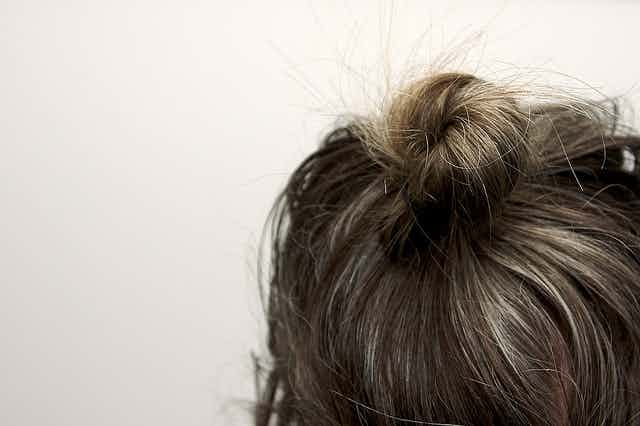Most of us find our first “greys” by the time we turn 30, usually at the temples, then later, across the scalp. While many people find the salt and pepper look appealing, others go to great lengths to conceal these locks.
The grey hair “rule of thumb” is that by the age of 50, half of the population have lost the colour in 50% of their hair. When researchers tested this rule, they found that 74% of people aged between 45 and 65 had grey hair, with an average intensity of 27%.
Generally, men have more grey hair than women. Asians and Africans have less grey hair than Caucasians.
What determines the colour of hair?
Hair colour is produced by cells known as melanocytes, which migrate into the hair bulb as the hair follicles develop in utero. The melanocytes produce pigment that is incorporated into the growing hair fibres to produce hair in a bewildering array of natural shades.
Hair colour depends on the presence and ratios of two groups of melanins: eumelanins (brown and black pigments) and pheomelanins (red and yellow pigments). While variations in the ratio of these pigments can produce an large number of colours and tones, siblings often have strikingly similar hair colour.
Hair colour varies according to body site, with eyelashes being darkest because they contain high levels of eumalanin. Scalp hair is usually lighter than pubic hair, which often has a red tinge, due to the presence of more phaeomelanin pigments. A red tinge is also common in underarm and beard hair, even in people with essentially brown hair on their scalp.
Hormones such as melanocyte-stimulating hormone can darken light hair, as can high levels of oestrogen and progesterone, which are produced in pregnancy. Certain drugs such as those to prevent malaria can lighten hair, while some epilepsy medications can darken it.

Blond children tend to see their hair darken around the age or seven or eight. The mechanism for this is unknown and probably not related to hormones, as the darkening precedes puberty by a number of years.
New parents often find the first coat of their baby’s hair is darker than expected. It is not until this first hair is shed and replaced, at around eight to 12 months of age, that you get a clear indication of their hair colour.
Growth
Human hair growth is cyclical. During the anagen phase, hair grows continuously at a rate of 1cm per month. Anagen can last three to five years on the scalp and produce hair that grows to between 36 to 60cm in length.
At the end of the anagen phase, the follicle turns off, hair growth stops and remains off for the three months. Towards the end of this resting (telogen) phase, the hair is shed and the follicle remains empty until the anagen phase of the cycle restarts.
Pigment production also turns on and off in rhythm with the hair cycle. When pigment cells turn off at the end of one hair cycle and fail to turn back on with the onset of the next, hair becomes grey.
Losing colour
Genetic factors appear to be important in determining when we turn grey. Identical twins seem to go grey at a similar age, rate and pattern, however we’re yet to identify the controlling genes.
There is no evidence to link the onset of greying to stress, diet or lifestyle. Certain autoimmune diseases such as vitiligo and alopecia areata can damage pigment cells and induce greying. However, these conditions are uncommon and can explain only a tiny fraction of greying.

Early greying occurs in premature ageing syndromes such as Hutchinson’s-progeria and Werner syndrome, where every aspect ageing in the body is accelerated. Premature greying can also be seen in people affected by pernicious anaemia, autoimmune thyroid disease or Down syndrome.
So, why doesn’t pigment production turn back on?
At the end of each hair cycle, some pigment-producing melanocytes become damaged and die. If the melanocyte stem cell reservoir at the top of the hair follicle can replenish the bulb, this keeps pigment production going. But when the reservoir of stem cells is exhausted, pigment production stops and the hair turns grey.
Scientists have long known that in order to prevent hair from going grey they would need to either prolong the life of the melanocytes in the hair bulb – by protecting them from injury – or expand the melanocyte stem cell reservoir in the upper or top region of the hair follicle so they continue to replace lost pigment cells.
A group of French scientists have identified a new series of agents that protect hair follicle melanocytes from damage at the end of the hair cycle. This enables pigment production to restart as soon as the next hair cycle begins.
The agents work by mimicking the action of an enzyme called DOPAchrome tautomerase. This enzyme is the naturally occurring antioxidant in the hair bulb that protects melanocytes from oxidative damage. By duplicating the effects of DOPAchrome tautomerase, melanocyte metabolism and survival improves.
The new agents are being formulated into a product that can be applied as a spray-on serum or shampoo. But they won’t re-colour grey hair or bring back the dead cells that produce hair colour. Instead, they protect your melanocytes.
So for those who cannot find it within themselves to embrace the salt and pepper look, new options are on the horizon.

